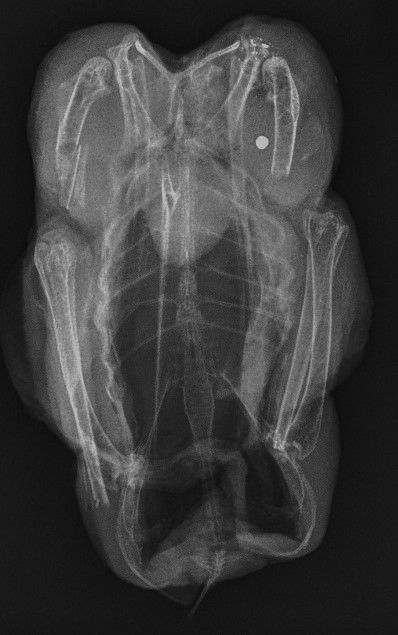Yesterday’s mystery bird was a Red Grouse.
And on closer inspection we see all the usual fragments of small pieces of lead (picked out (only some of them) with red arrows)
And here is a second Red Grouse…
And a larger image of part of the carcasse with the lead fragments indicated with red arrows and bone fragments with yellow arrows (and, to reiterate, the difference in brightness between the two types are very obvious on the X-rays, and less obvious in these images).
There are a couple more blogs to follow on this subject today (at 1200 and 1800).
But a few ‘thank you’s at this stage, as this approach was not my idea; it was the idea of someone we will call ‘TB’. And I didn’t do it all on my own, far from it, so Dr Ruth Tingay deserves huge amounts of credit. And the vet who did the X-rays and gave of her expertise certainly wishes to remain anonymous but ‘thank you’ to her too.
[registration_form]




Tim Boner?
Looks like Sainsburys are recommending grouse in their magazine, although I can’t find a date on this. Can we pass on the information about lead contamination?
http://www.sainsburysmagazine.co.uk/blog/food-news/item/why-you-should-try-game
I don’t shop with them – do they sell grouse?
A picture is worth a thousand words.
I’m not sure I would pay £35 to do it but I would find it hilarious if your next X Ray was of a grouse served on a plate from Rules!
What you need here is a control. An Xray of a grouse that hasn’t been shot but prepared in the same way. Also taking a sample of the contaminated meat and assaying for lead would make the whole story bulletproof scientifically (pun intended).
Gerard – if you go back and read Mystery bird competition (4) you will see that lead levels have been measured in game birds and mammalian game shot with lead shot or bullets.
The fact that birds are bilaterally symmetrical also gives you a ‘sort of’ visual control in each of the X-rays.
Therse posts were to illustrate what we already know – lead fragments in the flesh of shot game and that lead is distributed through the body away from the individual pellets.
There is lots of proper science that has been done on this subject, much of which is accessible through posts on this blog (click on ‘lead’ in categories, look at the individual blog posts, and follow links if you really want to see them). Or wait for further developments.
Mark, I am a chemist. I think in terms of showing clearly the point you are making to an audience, not necessarily an academic one. That is the format that a scientific paper would take (except that for a scientific paper the audience is clearly academic, in any case you need to convince them clearly). I had read some of the links already by the time I made the previous comment. Did you know that if you shoot a sample containing lead with higher energy X-rays or gamma radiation the lead emits specific lead X-rays. These could be used to clearly quantify the amount of lead in a sample. I am sure that there would be a suitable spectrometer somewhere in the country. There is also the possibility of using some free on-line data analysis software called Imagequant, to try and extract the amount of lead directly from the X-ray photo. However this is the sort of thing you would give to a first year PhD student to do as it would be very laborious.
My point was really to with the response of people like Tim Boner to your article who are clearly scientifically lazy and do not read the links. They kind of think that they are off the hook after reading it because the proof, is not presented on the page, but much of it elsewhere. If you refused them the opportunity to think they are getting off the hook it might help these people to understand. I have actually spent much time this week arguing with people on-line who clearly don’t get the evidence.